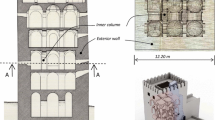Abstract
Based on the analogy with the load path of a homogeneous hanging chain, catenary has been for over three centuries considered to be an ideal masonry arch’s shape. In the present research, after the thrust line theory, complete insight into the equilibrium analysis of catenary arch of finite thickness under its own weight is provided. It is concluded that, in accordance with the common criterion—the existence of only normal (axial) forces—the ideality has previously been unjustifiably attached to such an arch, since there are shear forces present as well. However, with respect to so-called Couplet-Heyman’s assumptions (unilateral rigid no-tension material), it is shown that any catenary arch is stable under its own weight.






Similar content being viewed by others
References
Alexakis H, Makris N (2013) Minimum thickness of elliptical masonry arches. Acta Mech 224(12):2977–2991
Alexakis H, Makris N (2015) Limit equilibrium analysis of masonry arches. Arch Appl Mech 85(9):1363–1381
Bélidor BFd (1729) La science des ingénieurs dans la conduite des travaux de fortification et d’architecture civile. Paris
Benvenuto E (1991) An introduction to the history of structural mechanics. Springer, New York
Bernoulli J (1690) Analysis problematis antehac propositi, de inventione lineæ descensus a corpore gravi percurrendæ uniformiter, sic ut temporibus æqualibus æquales altitudines emetiantur: & alterius cujusdam Problematis Propositio. Acta Eruditorum, 217– 219
Bernoulli J (1704) Meditationes, annotationes, animadversiones theol. et philos. a me concinnatae et collectae ab anno 1677-1704
Bossut C (1774) Recherches sur l’Èquilibre des voûtes. Historie de l’Académie Royale des Sciences 1778:534–566
Cocchetti G, Colasante G, Rizzi E (2012) On the analysis of minimum thickness in circular masonry arches. Appl Mech Rev 64(5):27 pages
Como M (2017) Statics of historic masonry constructions. Springer, Berlin
Coulomb CA (1773) Essai sur une application des régles des maximis & minimis à quelques problémes de statique, relativs a larquitecture. Mémoires de Mathématique et de Physique, présentés à l’Académie Royal des Sciences per divers Savans, & lûs dans ses Assemblées 1776:343–382
Couplet P (1730) Seconde partie de l’examen de la poussee des voûtes. Histoire de l’Académie Royale des Sciences 1732:117–141
Cowan HJ (1981) Some observations on the structural design of masonry arches and domes before the age of structural mechanics. Archit Sci Rev 24(4):98–102
Foce F (2007) Milankovitch’s Theorie der Druckkurven: good mechanics for masonry architecture. Nexus Netw J 9(2):185–210
Gáspár O, Sipos AA, Sajtos I (2018) Effect of stereotomy on the lower bound value of minimum thickness of semi-circular masonry arches. Int J Archit Herit 12(6):899–921
Gregory D (1697) Catenaria. Phil Trans 19:637–652
Heyman J (1972) Coulombs memoir on statics: an essay in the history of civil engineering. Cambridge University Press, Cambridge
Heyman J (1997) The stone skeleton: structural engineering of masonry architecture. Cambridge University Press, Cambridge
Hooke R (1676) A description of helioscopes and some other instruments. John Martyn, London
Huerta S (2001) Mechanics of masonry vaults: the equilibrium approach. In: Lourenço PB, Roca P (eds) Historical constructions, pp 47–69
Huerta S (2006) Structural design in the work of Gaudí. Archit Sci Rev 49(4):327–339
Huerta S (2008) The analysis of masonry architecture: a historical approach. Archit Sci Rev 51(4):297–328
Kurrer KE (2018) The history of the theory of structures: searching for equilibrium, 2nd edn. Wilhelm Ernst & Sohn Verlag für Architectur und technische Wissenschaften GmbH & Co. KG
Lluis i Ginovart J, Coll-Pla S, Costa-Jover A, López Piquer M (2017a) Hookes chain theory and the construction of catenary arches in Spain. Int J Archit Herit 11(5):703–716
Lluis i Ginovart J, Costa-Jover A, Coll-Pla S, López Piquer M (2017b) Layout of catenary arches in the Spanish enlightenment and modernism. Nexus Netw J 19(1):85–99
Makris N, Alexakis H (2013) The effect of stereotomy on the shape of the thrust-line and the minimum thickness of semicircular masonry arches. Arch Appl Mech 83(10):1511–1533
Méry E (1840) Sur l’équilibre des voûtes en berceau. Annales des Ponts et Chaussées 1(1):50–70
Milanković M (1907) Theorie der Druckkurven. Zeitschrift für Mathematik und Physik 55:1–27
Moseley H (1843) The mechanical principles of engineering and architecture. Longman Brown, Green and Longmans, London
Nikolić D (2017) Thrust line analysis and the minimum thickness of pointed masonry arches. Acta Mech 228(6):2219–2236
Osserman R (2010) How the Gateway arch got its shape. Nexus Netw J 12(2):167–189
Poleni G (1748) Memorie istoriche della gran cupola del Tempio Vaticano. Stamperia del Seminario, Padova
Poncelet JV (1852) Examen critique et historique des principales théories ou solutions concernant l’équilibre des voûtes. Comptes rendus 35:577–587
Radelet-de Grave P (2003) Essays on the history of mechanics. Springer Basel AG, chap The use of a particular form of the parallelogram law of forces for the building of vaults (1650–1750), pp 135–163
Romano A, Ochsendorf JA (2010) The mechanics of Gothic masonry arches. Int J Archit Herit 4(1):59–82
Salimbeni L (1787) Degli archi e delle volte. Dionigi Ramanzini, Verona
Stirling J (1717) Lineæ tertii ordinis Neutonianæ. Oxford
Truesdell C (1960) The rational mechanics of flexible or elastic bodies 1638–1788. Introduction to Leonhardi Euleri Opera Omnia, 2nd series vol XI. Zürich, Orell Füssli
Ware S (1809) A treatise of the properties of arches, and their abutment piers. Longman Hurst, Rees and Orme, London
Young T (1824) Supplement to the fourth, fifth and sixth editions of the Encyclopaedia Britannica, vol 2. Archibald Constable, Edinburgh. Bridge, pp 497–520
Acknowledgements
I would like to thank Professor Ivica Bošnjak for providing valuable remarks and help regarding thrust line analysis carried out in this research. The paper was done within the Project No. TR36042 supported by the Ministry of Education, Science and Technological Development of the Republic of Serbia.
Author information
Authors and Affiliations
Corresponding author
Ethics declarations
Conflict of interest
The author declare that there is no conflict of interest.
Additional information
Responsible Editor: Mehmet Polat Saka
Publisher’s note
Springer Nature remains neutral with regard to jurisdictional claims in published maps and institutional affiliations.
Rights and permissions
About this article
Cite this article
Nikolić, D. Catenary arch of finite thickness as the optimal arch shape. Struct Multidisc Optim 60, 1957–1966 (2019). https://doi.org/10.1007/s00158-019-02304-9
Received:
Revised:
Accepted:
Published:
Issue Date:
DOI: https://doi.org/10.1007/s00158-019-02304-9




